Top image: Diemersdal winemakers, from left Juandré Bruwer, Thys Louw and Mari Branders.
With the Western Cape in the grips of a drought making headlines around the world, certain parts of the South African winelands are finding themselves in the midst of a grape harvest showing scant effects of the dry conditions. Thys Louw, proprietor and cellarmaster at Diemersdal Estate in the Durbanville region, says that despite rainfall leading up to harvest 2018 being 300mm less than the average of 680mm, the farm’s vines are producing good yields with grapes and the young wine showing excellent chemical analyses.
“We began harvesting Sauvignon Blanc, the signature grape on Diemersdal, about ten days later than average as phenolic ripeness was slow in setting in,” he says. “But two weeks into February grapes are coming in fast and furious. We are averaging 100 tons per day, with Sauvignon Blanc and the grapes for Diemersdal unwooded Chardonnay leading the way to the harvest bins. At this stage, yields are on average 10% lower than 2017, but one must remember that last year was a bumper crop due to some refreshing rains the vines saw a month before harvest .”
Louw believes the reason for the health of grapes and in yield can be attributed to the Diemersdal’s 200ha of vineyard being unirrigated. “We have been farming dryland vineyards for generations, and together with the relatively cool climate Durbanville experiences this is what characterises Diemersdal’s quality of fruit and the resulting wines,” he says.
“The roots of unirrigated vines run deep, able to access deep-lying moisture and coolness when the shallow soils are parched and hot. And due to the vines knowing they are not going to be spoilt by irrigation programmes they build-up a resilience to dry conditions, hence the relatively minimal effects of an otherwise devastating drought the Cape Winelands are experiencing.”
With Sauvignon Blanc, Chardonnay and Grüner Veltliner in the fermentation tanks, the young wines are showing tangy freshness, zest and underlying complexity. “Our first tanks of Sauvignon Blanc have fermented dry, and the wine will be in the bottle within a few weeks,” says Louw. “Not because we are impatient, but because the market is – South African demand for Sauvignon Blanc is increasing year-on-year and the moment the harvest season starts, people want to know when the new wines will be ready.”
Too early to call the overall quality of Harvest 2018, Louw says the early Sauvignon Blanc grapes are not as intensely aromatic as previous years. “The heat must have taken a lot out of some of the grapes, but the later-ripening blocks are showing terrific varietal character,” he says.




